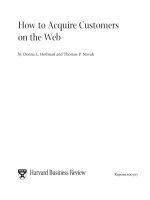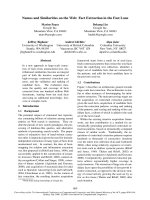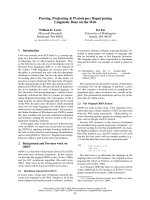thinking on the web berners-lee, godel and turing
Bạn đang xem bản rút gọn của tài liệu. Xem và tải ngay bản đầy đủ của tài liệu tại đây (4.42 MB, 292 trang )
THINKING ON THE WEB
Berners-Lee, G
¨
odel, and Turing
H. PETER ALESSO and CRAIG F. SMITH
A JOHN WILEY & SONS, INC., PUBLICATION
THINKING ON THE WEB
THINKING ON THE WEB
Berners-Lee, G
¨
odel, and Turing
H. PETER ALESSO and CRAIG F. SMITH
A JOHN WILEY & SONS, INC., PUBLICATION
Copyright © 2006 by John Wiley & Sons, Inc. All rights reserved
Published by John Wiley & Sons, Inc., Hoboken, New Jersey
Published simultaneously in Canada.
No part of this publication may be reproduced, stored in a retrieval system, or transmitted in any
form or by any means, electronic, mechanical, photocopying, recording, scanning, or otherwise,
except as permitted under Section 107 or 108 of the 1976 United States Copyright Act, without
either the prior written permission of the Publisher, or authorization through payment of the
appropriate per-copy fee to the Copyright Clearance Center, Inc., 222 Rosewood Drive, Danvers,
MA 01923, (978) 750-8400, fax (978) 750-4470, or on the web at www.copyright.com. Requests
to the Publisher for permission should be addressed to the Permissions Department, John Wiley &
Sons, Inc., 111 River Street, Hoboken, NJ 07030, (201) 748-6011, fax (201) 748-6008, or online at
/>Limit of Liability/Disclaimer of Warranty: While the publisher and author have used their best
efforts in preparing this book, they make no representations or warranties with respect to the
accuracy or completeness of the contents of this book and specifically disclaim any implied
warranties of merchantability or fitness for a particular purpose. No warranty may be created or
extended by sales representatives or written sales materials. The advice and strategies contained
herein may not be suitable for your situation. You should consult with a professional where
appropriate. Neither the publisher nor author shall be liable for any loss of profit or any other
commercial damages, including but not limited to special, incidental, consequential, or other
damages.
For general information on our other products and services or for technical support, please contact
our Customer Care Department within the United States at (800) 762-2974, outside the United
States at (317) 572-3993 or fax (317) 572-4002.
Wiley also publishes its books in a variety of electronic formats. Some content that appears in print
may not be available in electronic formats. For more information about Wiley products, visit our
web site at www.wiley.com.
Library of Congress Cataloging-in-Publication Data:
Alesso, H. P.
Thinking on the Web : Berners-Lee, G
¨
odel, and Turing / by H. Peter Alesso, Craig F. Smith.
p. cm.
“A Wiley-Interscience publication.”
Includes bibliographical references and index.
ISBN-13: 978-0-471-76814-2
ISBN-10: 0-471-76814-6
1. World Wide Web. 2. Artificial intelligence. 3. Semantic Web. I. Smith, C. F.
(Craig Forsythe), 1950- II. Title.
TK5105.888.A3755 2006
004.67
8–dc22
2006041614
Printed in the United States of America
10987654321
To: Chris and Kathy
CONTENTS
Foreword xiii
Preface xv
Acknowledgments xxi
Who This Book Is For xxiii
The Organization of This Book xxv
Associated Resources xxvii
PART I WHAT IS WEB INTELLIGENCE? 1
1 Empowering the Information Age 3
Overview 3
Thinking and Intelligent Web Applications 4
The Information Age 6
The World Wide Web 11
Limitations of Today’s Web 13
The Next Generation Web 14
Why Intelligent Ubiquitous Devices Improve Productivity 14
Conclusion 15
Exercises 16
Interlude #1: Thinking about Thinking 18
vii
viii CONTENTS
2G
¨
odel: What is Decidable? 21
Overview 21
Philosophical and Mathematical Logic 22
Kurt G
¨
odel 26
Knowledge Representation 32
Computational Logic 34
Artificial Intelligence 35
Web Architecture and Business Logic 36
The Semantic Web 37
Conclusion 40
Exercises 41
Interlude #2: Truth and Beauty 43
3 Turing: What is Machine Intelligence? 45
Overview 45
What is Machine Intelligence? 45
Alan Turing 46
Turing Test and the Loebner Prize 48
John Searle’s Chinese Room 49
Artificial Intelligence 49
Machine Intelligence 50
Semantic Networks and Frames 51
Reasoning with Semantic Networks 51
Computational Complexity 52
Description Logic 54
Ontology 55
Inference Engines 55
Software Agents 56
Adaptive Software 56
Limitations and Capabilities 57
Conclusion 57
Exercises 58
Interlude #3: Computing Machines 60
4 Berners-Lee: What is Solvable on the Web? 63
Overview 63
The World Wide Web 64
Tim Berners-Lee 64
The Semantic Web Roadmap 68
Logic on the Semantic Web 75
Conclusion 77
CONTENTS ix
Exercises 77
Interlude #4: Turing’s Test 79
PART II WEB ONTOLOGY AND LOGIC 81
5 Resource Description Framework 83
Overview 83
HTML Language 84
XML Language 84
RDF Language 86
Basic Elements 89
RDF Schema 95
XQuery: XML Query Language 100
Conclusion 102
Exercises 102
Interlude #5: The Chinese Room 104
6 Web Ontology Language 107
Overview 107
Ontology Language 108
Ontology Language Requirements 109
Compatibility of OWL and RDF/RDFS 109
The OWL Language 111
Basic Elements 112
OWL Example: Compute Ontology 117
Ontology Example: Birthplace 118
Applying OWL 120
OWL Capabilities and Limitations 120
Conclusion 121
Exercises 121
Interlude #6: Machines and Brains 123
7 Ontology Engineering 125
Overview 125
Ontology Engineering 125
Constructing Ontology 127
Ontology Development Tools 128
Ontology “Spot” Example 128
Ontology Methods 131
x CONTENTS
Ontology Sharing and Merging 132
Ontology Libraries 133
Ontology Matching 133
Ontology Mapping 135
Ontology Mapping Tools 135
Conclusion 136
Exercises 136
Interlude #7: Machines and Meaning 138
8 Logic, Rules, and Inference 143
Overview 143
Logic and Inference 144
Monotonic and Nonmonotonic Rules 147
Descriptive Logic 148
Inference Engines 149
RDF Inference Engine 152
Conclusion 155
Exercises 155
Interlude #8: Machines and Rules 157
9 Semantic Web Rule Language 161
Overview 161
Rule Systems 161
Rule Languages 162
Semantic Web Rule Language 163
Conclusion 164
Exercise 165
Interlude #9: Machines and Language 166
10 Semantic Web Applications 169
Overview 169
Semantic Web Applications 169
Semantic Web Services 171
Semantic Search 171
e-Learning 172
Semantic Bioinformatics 173
Enterprise Application Integration 173
Knowledge Base 175
Conclusion 175
Exercise 176
Interlude #10: Distributed Intelligence 177
CONTENTS xi
11 Web Ontology Language for Services 179
Overview 179
XML-based Web Services 180
Next Generation Web Services 180
Creating an OWL-S Ontology for Web Services 190
Conclusion 190
Exercises 190
Interlude #11: The Semantic Web 191
12 Semantic Search Technology 193
Overview 193
Search Engines 193
Semantic Search 196
Semantic Search Technology 197
Web Search Agents 199
Semantic Methods 201
Latent Semantic Index Search 201
TAP 203
Swoogle 204
Conclusion 206
Exercises 206
Interlude #12: The Halting Problem 207
13 Semantic Patterns and Adaptive Software 209
Overview 209
Patterns in Software Design 209
Pattern Frame 210
Semantic Patterns 211
Self-Organizing and Adaptive Software 213
Conclusion 214
Exercise 214
Interlude #13: The Semantic Web and Rules 215
14 Semantic Tools 217
Overview 217
Semantic Tools 217
Semantic Web Services Tools 221
Conclusion 224
Exercise 224
Interlude #14: The Semantic Web and Language 225
xii CONTENTS
15 Challenges and Opportunities 227
Overview 227
Semantic Doubts 228
Semantic Opportunities 229
The Challenges 229
Balancing Proprietary and Open Standards 231
Conclusion 232
Interlude #15: The Semantic Web and Zeno’s Paradox 234
Bibliography 235
Glossary 243
Acronyms 257
Index 259
FOREWORD
The modern world is becoming networked at an amazing rate. At the core of
this process of change is the revolutionary impact of information technology on
society through the World Wide Web (WWW). What is next in the development of
the WWW, an intelligent WWW? The authors of this enlightening book provide
a forward-looking approach to the development of an intelligent “semantic” web,
based on the classic works of G
¨
odel, Turing, and Berners-Lee.
G
¨
odel’s insights are essential in understanding the limits of logic applica-
tions through the discovery of decidability limits. Turing’s work defines the
basis of machine intelligence. The fresh new look at Berners-Lee sets up the
path for WWW evolution toward a new intelligent environment of the seman-
tic web.
The synergy of the ideas of G
¨
odel, Turing, and Berners-Lee illustrate the
emergence of a coherent philosophy of machine intelligence and AI, which pro-
vides a focus for the well-written text of this book. This approach allows the
authors to give insightful answers to critical questions concerning the capa-
bility of the Web to provide for machine intelligence and complex problem
solving.
The creative use of interludes between the chapters as a parallel set of dialogs
allows the authors to delve into some of the most important philosophical issues
underlying the exciting advance toward a new ideal, a semantic web. This writing
device not only provides insight, but is a delightfully enjoyable complementary
approach to the technology discussions of the text.
xiii
xiv FOREWORD
Overall, this book provides synergistic analysis and critical thinking that is
highly relevant to the ongoing societal revolution in information technology. It
offers a unique melding of big ideas with a style and approach that makes it a
delightful reading experience.
P
ROFESSOR ALEX BORDETSKY
Department of Information Science
Naval Postgraduate School
Monterey, California
PREFACE
Tim Berners-Lee, Kurt G
¨
odel, and Alan Turing are the pivotal pioneers who have
opened the door to the Information Revolution. Through their contributions, we
are witnessing the remarkable refashioning of the Information Age, which began
with the introduction of the computer in the 1950s, into the Information Revo-
lution as the World Wide Web evolves into a resource with intelligent features
and capabilities.
The contributions of G
¨
odel (what is decidable?), Turing (what is machine
intelligence?), and Berners-Lee (what is solvable on the Web?) are central to just
how much “intelligence” can be projected onto the Web.
Web intelligence is an issue of philosophy as much as application. It has been
suggested that the next generation of Web architecture, the Semantic Web, creates
an Artificial Intelligence (AI) application that will make Web content meaningful
to computers, thereby unleashing a revolution of new abilities. More realistically,
however, the Semantic Web may add semantics to the Web along with some lim-
ited AI capabilities to produce a more useful Web. Creating the Semantic Web
with just the right balance between greater logic expressive power and achievable
computer reasoning complexity is still being questioned and analyzed. An overly
structured layering of many languages to deliver logic and machine processing
would probably over-design the future Web architecture leading to a top-down
command structure and weak adoption in the development community. The goal
of this book is to present and explore many of the challenging issues in achiev-
ing the appropriate balance of powerful reasoning with reasonable complexity
on the Web.
xv
xvi PREFACE
BACKGROUND
The Greek philosopher Aristotle considered intelligence to be the main distin-
guishing feature of humans when he described man as a “rational animal.” He
also established many precedents in the study of logic and began the process of
codifying syllogisms, a process later extended by the mathematician Leibnitz. In
addition to his work in developing the mathematics of calculus, Leibnitz initiated
an effort to represent human logic and reasoning as a series of mechanical and
symbolic tasks. He was followed by logicians, such as by George Boole, who
developed Boolean logic, paving the way for the use of mechanical rules to carry
out logical deductions.
While it is still not possible to resolve controversial differences of opinion over
the nature of human intelligence, it is possible to recognize certain attributes that
most would agree reflect the concept. These include such attributes as: the ability
to learn; the ability to assimilate information; the ability to organize and process
data; and the ability to apply knowledge to solve complex problems. By extension
then, many of these real intelligence attributes can be traced into the various areas
of research in the field of artificial intelligence. Artificial Intelligence addresses
the basic questions of what it means for a machine to have intelligence.
WHAT IS DECIDABLE?
In the 1930s, the mathematical logician, Kurt G
¨
odel, established that, in certain
important mathematical domains, there are problems that cannot be solved or
propositions that cannot be proved, or disproved, and are therefore undecidable.
Whether a certain statement of first-order logic is provable as a theorem is one
example; and whether a polynomial equation in several variables has integer
solutions is another. While humans solve problems in these domains all the time,
it is not certain that arbitrary problems in these domains can always be solved.
This is relevant for artificial intelligence, since it is important to establish the
boundaries for a problem’s solution.
One critical area explored in this book involves the implications of G
¨
odel’s
discovery for the World Wide Web.
WHAT IS MACHINE INTELLIGENCE?
In 1947, shortly after the end of World War II, English mathematician Alan Turing
first started to seriously explore intelligent machines. By 1956, John McCarthy
of MIT contributed the term “Artificial Intelligence.” By the late 1950s, there
were many researchers in AI most basing their work on programming computers.
Eventually, AI became more than a branch of science: It expanded far beyond
mathematics and computer science into fields such as philosophy, psychology,
and biology.
PREFACE xvii
However, in Turing’s seminal work, more than 50 years ago, he determined
that a computer can be called intelligent if it could deceive a human into believing
that it was human. His test—called the Turing Test—consists of a person asking
a series of questions of both a human subject and a machine. The questioning
is done via a keyboard so that the questioner has no direct interaction with the
subjects, human or machine. A machine with true intelligence will pass the Turing
Test by providing responses that are sufficiently human-like that the questioner
cannot determine which responder is human and which is not. A scaled down
version of the Turing Test, known as the Loebner Prize, requires that machines
“converse” with testers only on a limited topic in order to demonstrate their
intelligence.
As participants of the Information Age, we could ask: “Is the World Wide
Web intelligent?” For the most part, the Web can be considered to be a massive
information system with interconnected databases and remote applications pro-
viding various services. While these services are becoming more and more user
oriented, the concept of smart applications and services on the Web is still in its
infancy, and today we could not refer to the Web as intelligent.
In this book, however, we will examine how the Web may be pushing the
boundaries of intelligence and Turing’s Test. We will consider how the Semantic
Web’s goal of machine processing using powerful reasoning with reasonable
computational complexity relates to the concept of machine intelligence.
WHAT IS SOLVABLE ON THE WEB?
In the late 1980s, AOL, CompuServe, and Microsoft were investing fortunes
in proprietary networks that offered mostly duplicated and limited amounts of
information to the public for a fee. It was Tim Berners-Lee who designed a cheap,
efficient, and simple way for free universal access to great stores of information.
As a result, today’s Web is essentially hypertext for human consumption. The
next generation Web, however, may need to extend these capabilities to automatic
machine processing.
As the inventor of the World Wide Web, Tim Berners-Lee is also the originator
of the proposed next generation Web architecture: the Semantic Web. Currently,
his World Wide Web Consortium (W3C) team works to develop, extend, and
standardize the Web’s markup languages and tools. The objective of the Semantic
Web architecture is to provide a knowledge representation of linked data in order
to allow machine processing on a global scale. To provide this, the W3C has
developed a new generation of open markup languages that are now poised to
unleash the power, flexibility and, above all, logic of the next generation of
the Web.
While search engines that index Hypertext Markup Language (HTML) pages
find many answers to searches and cover a huge part of the Web, they also return
many irrelevant results. There is no notion of “correctness” to such searches. And
the growth of the Web has resulted in a combinatorial explosion of possibilities
that is becoming quite intractable.
xviii PREFACE
By contrast, logic (inference) engines could apply reasoning power to solve
problems on the Web. However, while these engines have been able to restrict
their output to provably correct solutions, they suffer from computation complex-
ity limitations as they go through the mass of connected data across the Web.
The issue of what is solvable on the Web is directly related to reaching a balance
of powerful expressive reasoning with reasonable computational complexity.
The objective of the Semantic Web is therefore to provide the best framework
for adding logic, inference, and rule systems to the Web. A combination of
mathematical and AI issues complicates this task. The logic must be powerful
enough to describe complex properties of objects, but not so powerful that agents
can be tricked when asked to consider a paradox.
If an engine of the future combines a reasoning engine with a search engine,
it may actually be able to produce useful results. It will be able to reach out to
indexes that contain very complete lists of all occurrences of a given term, and
then use logic to weed out all but those that can be of use in solving the given
problem.
Two important technologies for developing the Semantic Web are already
in place: eXtensible Markup Language (XML) and the Resource Description
Framework (RDF). eXtensible Markup Language lets anyone create their own
tags. Scripts or programs can make use of these tags in sophisticated ways, but
the scriptwriter has to know how the page writer uses each tag. In short, XML
allows users to add arbitrary structure to their documents, but says nothing about
what the structure means. Resource Description Framework was developed to
extend XML. The goal of RDF is to make work easier for autonomous agents
and automated services by supplying a rudimentary semantic capability.
The next steps up the Language Pyramid of the Web include the Web Ontology
Language (OWL) and a rule systems markup capability.
The Semantic Web will develop software agents that can interpret informa-
tion and perform a service automatically. Differences in terminology between
businesses will be resolved using standard abstract domain models, and data will
be exchanged using translation services. Software agents will be empowered to
auction, negotiate, and draft contracts automatically.
Achieving powerful reasoning with reasonable complexity is the ultimate goal
for the Semantic Web because it will lead to machine processing and services
automation on a global scale. The challenge is finding the best layering of ontol-
ogy, logic, and rule markup languages for the Semantic Web that will offer
solutions to the most useful Web information processing. Essentially, Berners-Lee
is designing the Semantic Web to find what is solvable on the Web.
THIS BOOK
Important mathematical and practical limitations present serious challenges for
development of the Semantic Web. These limitations touch some of the most
difficult problems in mathematics and logic, such as machine intelligence, unde-
cidability, paradox, recursion, and computational complexity. Throughout the
PREFACE xix
book we struggle with both abstract and practical questions in order to delineate
both the opportunities and challenges.
In addition, we present Web Ontology and Logic: the solution of the W3C to
deliver machine processing and services automation on a global scale through
Semantic Web architecture built upon layers of open markup languages.
Finally, we highlight some of the philosophical issues that underpin the Infor-
mation Revolution with a threaded series of vignettes between the chapters.
Our goal with this book is to offer a stimulating as well as practical view of
“Thinking” on the Web.
ACKNOWLEDGMENTS
We are grateful to the online discussion forums, papers, research, and sugges-
tions of the DAML Services Coalition (also known as the OWL-S Coalition)
as a whole: Anupriya Ankolenkar, Mark Burstein, Grit Decker, Jerry Hobbs,
Ora Lassila, David Martin, Drew McDermott, Sheila McIlraith, Srini Narayanan,
Massimo Paolucci, Bijan Parsia, Terry Payne, Marta Sabou, Monika Solanki, Tran
Cao Son, Naveen Srinvasan, Katia Sycara, and Honglei Zeng. They generously
shared their ideas and work with regard to OWL-S Semantic Web Services.
Thanks to the World Wide Web Consortium www.w3.org/, which provides
not only recommendations and specifications, but references, discussion groups,
documentation, and software tools for public review. In particular, Chapters 5,
6, and 9 were drawn in part from the published material of www.w3.org.
We are indebted to several organizations for the special permission granted to
include material from previous works including: “Print Gallery” by M. C. Escher,
The M. C. Escher Company-Holland (www.mcescher.com), “The Escher and the
Droste Effect” by Hendrik Lenstra and Bart de Smit (escherdroste.math.leide-
nuniv.nl/), various figures and tables from the authors’ previous work with pub-
lishers Addison-Wesley and A. P. Peters, Inc., and the “spot” example from the
work of X. Wang (charlestoncore.musc.edu/ont/example/).
We would like to acknowledge The Cambridge Quintet by J. L. Casti as the
inspiration for many of the debate concepts included in the interludes presented
between the chapters of this book. We would also like to acknowledge Semantic
Web Pri mer by G. Antoniou and F. van Harmeten as the inspiration for several
logic examples presented. We thank G. Naudts (www.agfa.com/w3c/2002/02/
thesis/An
inference engine for RDF.html) as the inspiration for the RDF infer-
ence engine example presented in Chapter 8. We acknowledge the many contrib-
utors to forums and public discussion groups including: ,
xxi
xxii ACKNOWLEDGMENTS
, and It is not possible to
identify individual authors of each particular thread of various inspiring ideas,
however, the contributions have added to the overall public knowledge and under-
standing of many important issues relevant to machine intelligence.
In addition, we would like to acknowledge the outstanding guidance and assis-
tance of George J. Telecki, Associate Publisher at Wiley-Interscience and his
staff, including Rachel Witmer and Kellsee Chu, in the preparation of this work.









